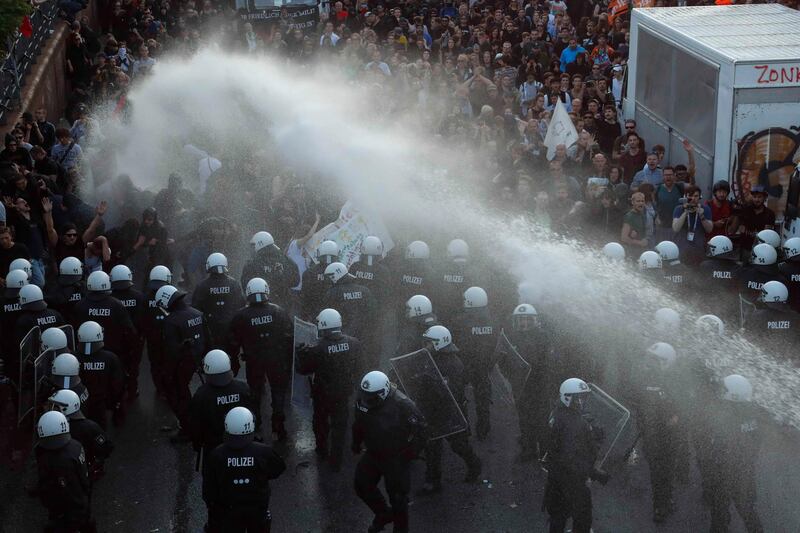HAMBURG// Police fired water cannons at protesters against the Hamburg G20 on Thursday night as fears of violence grew from fear to reality on the eve of the opening of the two-day summit attended by US President Donald Trump, Russia’s Vladimir Putin and Turkey’s Recep Tayyip Erdogan.
A massive demonstration had been orchestrated by the militant anti-G20 “Welcome to Hell” group to coincide with leaders, including Mr Trump, arriving on a series of special flights into the northern German city throughout the day.
As with some earlier protests, it began peacefully but degenerated before dusk fell. Police ordered marchers to remove face coverings as they tried to continue their march in defiance of security cordons.
At least 76 police officers were injured in clashes with anti-G20 protesters, authorities said.
A renewed demonstration was under way as Theresa May arrived in Hamburg ahead of the summit at about 10pm (GMT).
There were no figures for the number of demonstrators injured.
The violence began when police charged masked demonstrators at a "Welcome to hell" march attended by 12,000 people.
Police sources said bottles and objects were aimed at officers and there were scenes of jostling as protesters pushed against police lines.
Water cannons were fired in an attempt to disperse the crowd, as they had been during another protest on Tuesday night.
Although estimates vary widely, tens of thousands of anti-capitalist demonstrators are already in Hamburg or making their way there to register their opposition to the summit in a manner as powerful and visible as possible.
As Thursday night’s protest veered into the violent confrontation most observers predicted – and many of the more militant activists wanted - police asked "non-participants" to leave the area in the Saint Pauli district of the city.
Both sides will seize on the events to support their own versions, protesters accusing police of being heavy handed and police chiefs pointing out that with so many of the demonstrators bent on causing trouble, they cannot be relaxed.
Attacks on property – railway tracks sabotaged and cars set on fire at a Porsche dealership in Hamburg on Wednesday night – have become a feature of protest tactics. Even the more publicly vocal of anti-G20 groups have stopped short of disowning violence and criminal damage but concentrated on advising activists on police tactics and avoidance of arrest.
As pockets of trouble broke out in several parts of Hamburg city centre, with flashing blue lights of police and fire service vehicles a common sight, those caught up in the clashes spoke of their experiences.
“It wasn’t too bad,” said a man giving his name as Leu, on his way home with his big drum after witnessing events in the entertainment and red light district of Reeperbahn.
“The two sides, protesters and police, were sort of pushing each other. Then they started firing the water. Strangely, it felt quite warm. But I did see some people with blood on their faces so it wasn’t all right for everyone.”
Outside Reeperbahn station, a young women said: “Plenty of people were hurt. The police started it by going for people in the crowd like they wanted there to be trouble.”
Nearby, with police helicopters still buzzing in the sky, a group of medics sympathetic to the demonstrations said they had treated several protesters for injuries.
Police – and the city of Hamburg – are resigned to three more days of potential trouble, ranging from isolated incidents to street riots, breaking out before the summit closes on Saturday night.
Among the huge number of protesters converging on the city, a large majority probably believe essentially in non-violent protest.
But German authorities say up to 8,000 of those expected in the city are committed to disrupting the summit with violence and that this justifies the deployment up to to 20,000 officers in a counter-show of strength.
No one believes the clashes on Thursday night will be the the last before world leaders begin to depart after the conference closes on Saturday.







